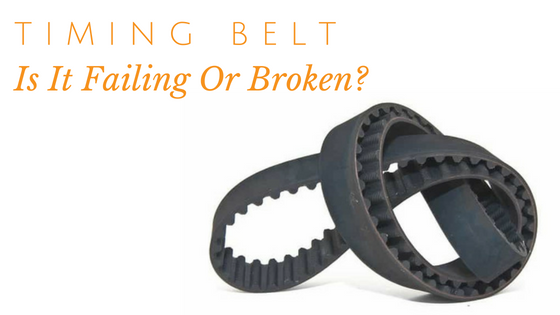The timing belt is essential to the proper function of your engine. Your timing belt acts as a link between the two most important halves of your car’s engine allowing for proper air flow, at the correct time, within your engine.
Due to its importance and the immense force under which a timing belt functions, it is essential to replace your timing belt routinely as recommended by your vehicle’s user guide.
Even when following the guidelines set forth by your vehicle’s manufacturer it is important to know what signs to look for in a failing or broken timing belt in order to replace your belt before any permanent damage is done to your vehicle.
Symptoms Of A Failing Or Broken Timing Belt
We have compiled the most common symptoms of a failing or broken timing belt to help you recognize the signs and bring them to the attention of a licensed professional.
1. You Hear Odd Noises Coming From The Engine
A failing timing belt can produce a well-known “ticking” noise that will emanate from your engine. This ticking noise can also be a sign of low oil pressure within your engine, if you check your oil and your level is within a normal range, consult your mechanic to inspect your timing belt.
2. Your Check Engine Light Is On And Flashing
A flashing check engine light is a sign that your car has picked up on an issue within the engine, typically for a timing belt failure or issue these lights will signal a CAM shaft/crank shaft correlation code.
These codes can be diagnosed by a vehicle maintenance trained technician at your local mechanics shop.
3. Your Car Starts Hard And Occasionally Misfires
If your timing belt is failing or worn out it can slip and cause the cylinders in your car’s engine to open and close out of sync. This can cause an engine misfire, which means you should replace your timing belt immediately.
4. You Notice A Loss Of Power And Your Car Runs Or Idles More Roughly Than Normal
Your timing belt is constructed with “teeth” that grip gears as it rotates your engines moving parts. If these teeth break or fall off, you will notice your car start to slip gears which can lead to failure and stalling of your engine.
Alternatively, your timing belt can “jump a tooth” causing your vehicle to suffer from loss of power. You will notice rough running conditions; including, odd idling and flashing check engine light.
What Should You Do If Your Vehicle Is Having Timing Belt Issues?
Generally, timing belts should be replaced every 60-80,000 miles. Check your car’s specific manual for service intervals.
If you have no record of your timing belt being replaced, you should have your belt inspected at 60,00 miles. Failure to maintain or replace your timing belt can result in catastrophic engine failure which can cost you thousands.
It is important to remember that preventative maintenance is a much cheaper job than mandatory maintenance. If you believe that your timing belt is failing or broken, get your timing belt inspected by an ASE certified mechanic who will be able to fully inspect and diagnose any issues.
For more information about vehicles and the products you need to care for them, contact Berryman Products today!

